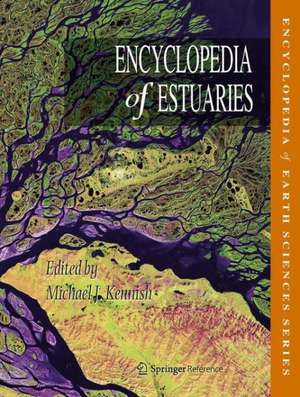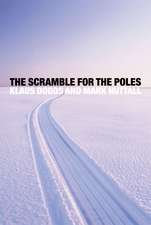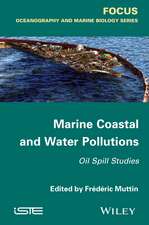Encyclopedia of Estuaries: Encyclopedia of Earth Sciences Series
Editat de Michael J. Kennishen Limba Engleză Hardback – 14 aug 2015
Din seria Encyclopedia of Earth Sciences Series
- 18%
 Preț: 3655.93 lei
Preț: 3655.93 lei - 18%
 Preț: 3123.97 lei
Preț: 3123.97 lei - 18%
 Preț: 2565.22 lei
Preț: 2565.22 lei - 18%
 Preț: 2828.03 lei
Preț: 2828.03 lei - 18%
 Preț: 3984.35 lei
Preț: 3984.35 lei - 18%
 Preț: 3380.49 lei
Preț: 3380.49 lei - 18%
 Preț: 3917.94 lei
Preț: 3917.94 lei - 18%
 Preț: 3664.42 lei
Preț: 3664.42 lei - 18%
 Preț: 1901.16 lei
Preț: 1901.16 lei - 18%
 Preț: 3381.42 lei
Preț: 3381.42 lei - 18%
 Preț: 3041.93 lei
Preț: 3041.93 lei - 18%
 Preț: 3055.49 lei
Preț: 3055.49 lei - 24%
 Preț: 2488.11 lei
Preț: 2488.11 lei - 24%
 Preț: 2672.36 lei
Preț: 2672.36 lei - 18%
 Preț: 1849.26 lei
Preț: 1849.26 lei - 24%
 Preț: 3581.28 lei
Preț: 3581.28 lei - 18%
 Preț: 2802.01 lei
Preț: 2802.01 lei - 24%
 Preț: 1685.69 lei
Preț: 1685.69 lei - 18%
 Preț: 3335.19 lei
Preț: 3335.19 lei - 24%
 Preț: 2953.23 lei
Preț: 2953.23 lei - 24%
 Preț: 1685.16 lei
Preț: 1685.16 lei - 24%
 Preț: 1689.69 lei
Preț: 1689.69 lei - 14%
 Preț: 2198.30 lei
Preț: 2198.30 lei - 9%
 Preț: 1677.87 lei
Preț: 1677.87 lei - 14%
 Preț: 1632.61 lei
Preț: 1632.61 lei - 14%
 Preț: 1849.25 lei
Preț: 1849.25 lei - 14%
 Preț: 2571.45 lei
Preț: 2571.45 lei - 14%
 Preț: 1945.55 lei
Preț: 1945.55 lei - 14%
 Preț: 1945.55 lei
Preț: 1945.55 lei - 14%
 Preț: 1945.55 lei
Preț: 1945.55 lei - 14%
 Preț: 1945.55 lei
Preț: 1945.55 lei - 9%
 Preț: 2703.17 lei
Preț: 2703.17 lei - 14%
 Preț: 1945.55 lei
Preț: 1945.55 lei - 14%
 Preț: 1945.55 lei
Preț: 1945.55 lei - 14%
 Preț: 2130.90 lei
Preț: 2130.90 lei
Preț: 3354.74 lei
Preț vechi: 4091.15 lei
-18% Nou
Puncte Express: 5032
Preț estimativ în valută:
642.13€ • 697.73$ • 539.74£
642.13€ • 697.73$ • 539.74£
Carte disponibilă
Livrare economică 31 martie-14 aprilie
Preluare comenzi: 021 569.72.76
Specificații
ISBN-13: 9789401788007
ISBN-10: 9401788006
Pagini: 765
Ilustrații: XXIX, 760 p. 330 illus., 197 illus. in color.
Dimensiuni: 210 x 279 x 37 mm
Greutate: 2.39 kg
Ediția:1st ed. 2016
Editura: SPRINGER NETHERLANDS
Colecția Springer
Seria Encyclopedia of Earth Sciences Series
Locul publicării:Dordrecht, Netherlands
ISBN-10: 9401788006
Pagini: 765
Ilustrații: XXIX, 760 p. 330 illus., 197 illus. in color.
Dimensiuni: 210 x 279 x 37 mm
Greutate: 2.39 kg
Ediția:1st ed. 2016
Editura: SPRINGER NETHERLANDS
Colecția Springer
Seria Encyclopedia of Earth Sciences Series
Locul publicării:Dordrecht, Netherlands
Public țintă
ResearchCuprins
Adaptive Governance.- Adaptive Management.- Aerobic Environments.- Age.- Airborne Laser Terrain Mapping (ALTM).- Algal Blooms.- Alkalinity.- Amphipods.- Anadromous.- Anaerobic Environments.- Anoxia, Hypoxia, and Dead Zones.- Anthropogenic Impacts.- Archaea.- Artificial Reef.- Autotrophic.- Back Dune.- Backbarrier.- Bar.- Barrier Island.- Barrier Spits.- Beach Management.- Beach Processes.- Benthic Ecology.- Bioaccumulation.- Bioavailability.- Biochemical Oxygen Demand.- Biogenic Sedimentary Structures.- Biogenous Sediment.- Bioindicators.- Biomagnification.- Biomonitors.- Bioremediation.- Bivalve Aquaculture.- Bivalve Molluscs.- Blue Carbon.- Blue Crabs.- Bulkheads.- Carbon Sequestration.- Cheniers and Regressive Bedforms.- Clean Water Act.- Climate Change.- Coastal Barriers.- Coastal Bays.- Coastal Cliffs.- Coastal Erosion Control.- Coastal Indicators.- Coastal Lagoons.- Coastal Landforms.- Coastal Risks: Floods.- Coastal Squeeze.- Coastal Wetlands.- Cordgrass.- Cultural Seafood Management.- Cyanobacteria.- Delta Plain.- Deltas.- Density Stratification.- Determining Geoheritage Values.- Detritus Food Webs.- Diagenesis.- Diffusion.- Dispersion.- Dissolved Oxygen.- Dredge and Fill.- Dredging.- Earthquake Disturbances.- Ecological Modeling.- Ecological Monitoring.- Ecological Niche.- Ecological Stoichiometry.- Ecological Succession.- Ecosystem-Based Management.- Ecotourism.- Emergent Shoreline.- Endemic Species.- Environmental Gradients.- Epibiont.- Estuarine Beaches.- Estuarine Circulation.- Estuarine Connectivity.- Estuarine Deltaic Wetlands.- Estuarine Flocculation.- Estuarine Geomorphology.- Estuarine Habitat Restoration.- Estuarine Sediment Composition.- Estuarine Sedimentation.- Estuarine Sustainability.- Estuarine Total Ecosystem Metabolism.- Estuary Conservation.- Estuary Conservation Zone.- Eutrophication.- Evaporation and Transpiration.- Exotic Species.- Extratropical Storms.- Extreme Events (Hurricanes).- Fiddler Crabs.- Firth.- Fish Assemblages.- Fjord.- Flocculation.- Flushing Time.- Food Chain.- Food Web/Trophic Dynamics.- Foredune.- Forested Wetland Habitat.- Fringing Reef.- Geoheritage.- Geomorphological Mapping.- Glaciated Estuarine Systems.- Habitat Complexity.- Habitat Loss.- Halocline.- Halogenated Hydrocarbons.- Headland Breakwaters.- Heavy Minerals.- Herbivorous Grazers.- Herbivory.- Heterotrophic.- Ichthyofauna.- Ichthyoplankton.- Infauna.- Intertidal Zonation.- Introduced Species.- Invasive Species.- Karst Processes and Estuarine Coastlines.- Kelp Forests.- Light Detection and Ranging (LIDAR).- Littoral Cordon.- Littoral Zone.- Lobster Migration.- Macroalgae.- Macroalgal Blooms.- Macrofauna.- Macronutrients.- Managed Realignment.- Mangroves.- Marine/Freshwater Mixing.- Marsh Drowning.- Marsh Islands.- Marsh Sediment Toxicity.- Mass Physical Sediment Properties.- Mean Sea Level.- Meiofauna.- Microbial Degradation.- Microbial Survivability.- Microfauna.- Micronutrients.- Microphytobenthos.- Mineralization.- Mixotrophic Plankton.- Mosquito Ditching.- Mutualism.- Nekton Behavioral Ecology.- Neural Networks.- Neuston.- Nitrate Reduction.- Nitrification.- Nitrogen.- Nonpoint Source Pollution.- Nonstationary Forcing.- Nutrient Dynamics.- Nutrient Limitation.- Nutrients.- Oil Pollution.- Overwash.- Oxygen Depletion.- Oyster Reef.- Participatory Research.- Pathogens.- Peat.- pH.- Pharmaceuticals.- Phi Scale.- Phosphorus.- Physiological Mechanisms.- Phytoplankton.- Phytoplankton Blooms.- Pneumatophores.- Polycyclic Aromatic Hydrocarbons.- Precautionary Principle.- Predator–Prey Relationships.- Public Trust Rights.- Redox Conditions.- Residence Time.- Residual Circulation.- Revetments.- Rhodolith/Maerl.- Ria.- River-Dominated Estuary.- Rocky Intertidal Shores.- Rocky Shore.- Salt Marsh Accretion.- Saltmarshes.- Sand Mining/Beach Sand Mining.- Sand Ridge.- Sandbanks.- Sandflat.- Seabirds.- Seagrass Production Models.- Sea-Level Change and Coastal Wetlands.- Secchi Disk.- Secondary Dune.- Sediment Budgets.- Sediment Compaction.- Sediment Erosion.- Sediment Grain Size.- Sediment Resuspension.- Sediment Sorting.- Sediment Toxicity.- Sediment Transport.- Sedimentary Structures.- Seiche.- Shannon-Weaver Diversity Index.- Shell Beds.- Shellfish Production.- Shore Protection.- Shorebirds.- Shoreline.- Shoreline Changes.- Shoreline Undulations.- Side-Scan Sonar Imaging of Sediment Bedload.- Soft Computing.- Soft Sediment Communities.- Soldier Crabs (Mictyridae).- Species Richness.- Species Zonation.- SPIT.- Storm Surges.- Stratigraphy Of Estuaries.- Structurally Dominated Estuary.- Subaqueous Soils.- Sublittoral zone.- Submerged Coasts.- Submergent Shoreline.- Sustainable Use.- Symbiosis.- Tectonic Eustasy.- Thermal Biology.- Tidal Asymmetry.- Tidal Datum.- Tidal Flat.- Tidal Flat Salinity Gradient.- Tidal Freshwater Habitat.- Tidal Hydrodynamics.- Tidal and Nontidal Oscillations.- Tidal Ranges.- Tidal Reflection.- Tides.- Timescale .- Tombolo.- Toxic Blooms.- Trace Metals in Estuaries.- Trophic Dynamics.- Turbidity.- Tychoplankton.- Uplifted Coasts.- Vulnerability Index.- Washover Fans.- Washovers.- Water Clarity.- Water Quality.- Water Resources and Climate Change.- Watershed.- Wave-Driven Sediment Resuspension.- Well-Mixed Estuary.- Wetlands .- Wetlands Reclamation.- Wrack.- Zooplankton.
Recenzii
“From algal blooms to delta plain to invasive species to microfauna to wetlands, users will find foundational information about the physical, chemical, and biological characteristics of estuaries. The book is easy to navigate as it lists individual topics in the table of contents, uses guide words, and provides subject and author indexes. … This reliable and scholarly resource is highly recommended for academic and public libraries.” (American Reference Books Annual ARBA, June, 2018)
Notă biografică
Michael J. Kennish is a world-class estuarine scientist and a research professor in the Department of Marine and Coastal Sciences at Rutgers University, New Brunswick, New Jersey (USA). In addition to his research on estuaries, Dr. Kennish has conducted biological and geological research on coastal ocean and deep-sea environments. Much of his research has involved the development and application of innovative methods to assess anthropogenic impacts and to determine the condition and health of coastal ecosystems. Dr. Kennish is the author or editor of 14 scholarly books in marine science, and he is the author or co-author of more than 170 articles in science journals and books. In addition, he has edited 7 compendium science journal special issues on various topics in marine science.
Textul de pe ultima copertă
The Encyclopedia of Estuaries, part of Springer's Encyclopedia of Earth Sciences Series, provides a single, state-of-the-art, comprehensive reference volume on estuaries for research scientists, educators, students, and others. Consisting of almost 270 subject entries in an easy-to-use format, this volume covers the physical, chemical, and biological characteristics of estuaries. In total more than 225 authors from around the world have contributed to the encyclopedia on such diverse subjects as biotic communities, essential habitats, food webs, fisheries, hydrology, pollution, conservation, and many more. The Encyclopedia of Estuaries will meet the needs of professionals worldwide by supplying detailed information from world-class estuarine and marine scientists as well as experts from other fields of study.
Caracteristici
Encompasses the broad spectrum of natural phenomena in estuarine systems Authoritatively and comprehensively details the state-of-the-art of estuarine science Unifies estuarine biology, chemistry, geology, and physics in a carefully edited reference work Reviews and clarifies current knowledge and recent advances on estuaries Constitutes a most comprehensive and multidisciplinary source of information on estuaries Includes supplementary material: sn.pub/extras







